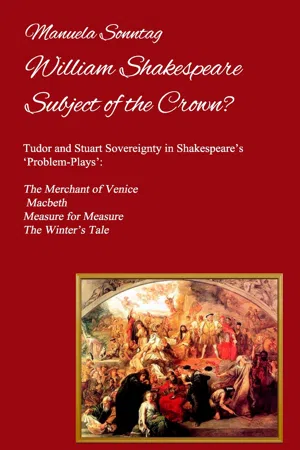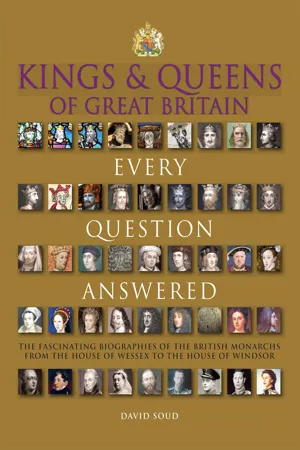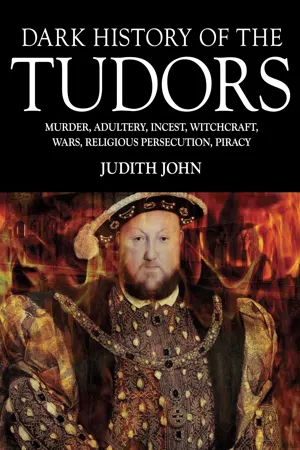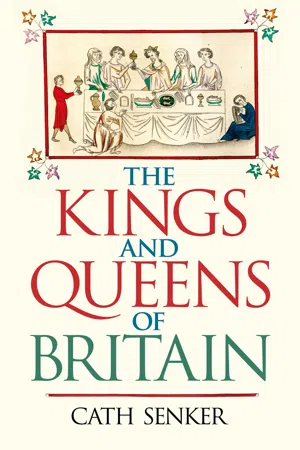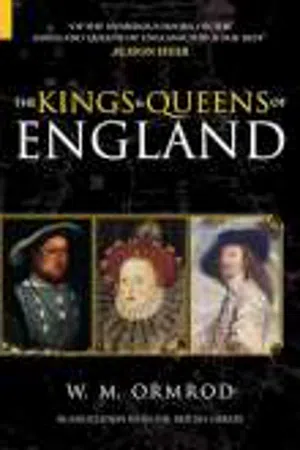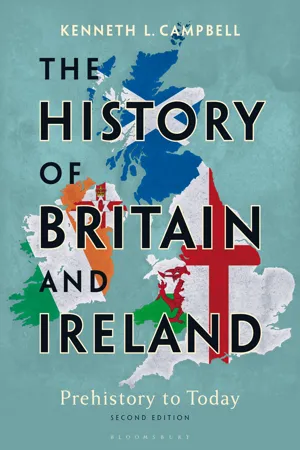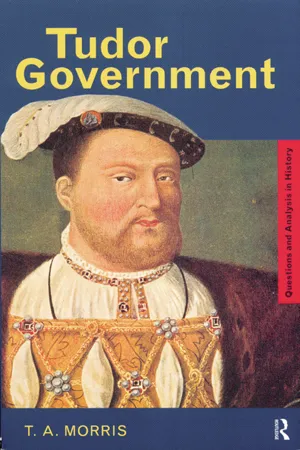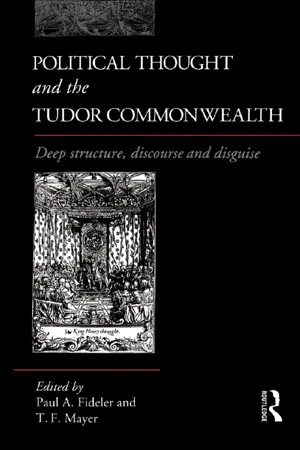History
The Tudor Dynasty
The Tudor Dynasty was a royal house that ruled England from 1485 to 1603. It was founded by Henry VII and included some of the most well-known monarchs in English history, such as Henry VIII and Elizabeth I. The Tudor period is characterized by significant religious and political changes, including the English Reformation and the expansion of England's influence abroad.
Written by Perlego with AI-assistance
Related key terms
10 Key excerpts on "The Tudor Dynasty"
- eBook - ePub
William Shakespeare - Subject of the Crown?
Tudor and Stuart Sovereignty in Shakespeare's 'Problem-Plays': The Merchant of Venice, Macbeth, Measure for Measure & The Winter's Tale
- Manuela Sonntag(Author)
- 2016(Publication Date)
- Books on Demand(Publisher)
The Tudor and Stuart AgeElisabeth I of England c. 1575 The "Darnley Portrait", National Portrait Gallery, LondonPassage contains an image
The English Renaissance
No other age in English history has brought to light so many aspects for the construction of an English national identity as the age of the Tudors.5The Tudor Dynasty ultimately arose from a decade of uncertainty and rebellion. The Wars of the Roses between the two ruling houses of Lancaster and York had brought terror and poverty to most of the English lands. Nevertheless, the rise of the Tudor house was unexpected, Henry Tudor having only an evanescently small claim to the Lancaster lineage. Indeed he was one of the few noble persons in the realm who had almost no claim to the throne at all.6The Tudor line of kings had to trace their legitimacy back to Queen Catherine, a French princess and wife of King Henry V, who was illegally married a second time to her Welsh chamberlain Owen Tudor – the proclaimed kinship to the House of Lancaster did therefore only exist through marriage and neither French nor Welsh nobility was sufficiently respected to support an attempt at kingship. But like many great royal houses the Tudors had mastered the art of political marriage. Thus the son of Queen Catherine, who was not a Lancaster in her own right, was married to Princess Margaret Beauford, who was. The Beaufords were one of the most powerful Lancaster families and provided the support that was needed for Henry VII to finally seize power, both the Lancaster and York clans having lost too many of their princes, after the battle of Bosworth. He then made another clever move in marrying Elisabeth of York. The people of England and Wales were desperate for the civil war to end and their wish for peace became the leading argument for their loyalty to the Tudor house which finally united the ‘two roses’.Nevertheless, the shadow of unrightful kingship remained constantly hovering behind the Tudor ancestry, as did the accusation of bastardy. As mentioned before, these two are the central themes that unite the Tudors, the Stuarts and some of Shakespeare’s ruling houses. - eBook - ePub
Kings & Queens of Great Britain
Every Question Answered
- David Soud(Author)
- 2014(Publication Date)
- Thunder Bay Press(Publisher)
The House of TudorAfter the Wars of the Roses had effectively culled the nobility of England, Henry Tudor was there to pick up the pieces, and he founded the dynasty that brought England into the modern era. Though it only lasted a little over a century, The Tudor Dynasty transformed England completely. Henry VIII, brilliant as he was brash, made England a Protestant nation; his daughter Elizabeth I would keep it so, however ruthlessly, and in the process guide the nation through several dangerous decades to secure its place as a major European power. Under the Tudors, British culture blossomed spectacularly. It was the age of William Shakespeare and Francis Bacon. Here was Britain’s Renaissance.HENRY VII Remaker of the Monarchy
H enry VII was an unlikely founder of England’s most storied dynasty, but he proved a capable and forward-thinking monarch. In the wake of the Wars of the Roses, he fended off multiple challenges to his rule and left his heirs a legacy of shrewd diplomacy, tight-fisted control of the nobility, and enormous royal wealth.House TudorBorn January 28, 1457Died April 21, 1509Reigned 1485–1509Consort Elizabeth of York (died 1503);Children Eight, including Henry VIIISuccessor Henry VIIIIN GOVERNMENT HE WAS SHREWD AND PRUDENT, SO THAT NO ONE DARED TO GET THE BETTER OF HIM THROUGH DECEIT OR GUILEMargaret of York, known after marriage as Margaret of Burgundy. The sister of Edward IV and Richard III, she was an implacable enemy of Henry VII, supporting the bids of both Lambert Simnel and Perkin Warbeck to usurp the English throne.POLYDORE VERGILWhen Richard III was unhorsed and slain at Bosworth, his adversary, Henry Tudor, found himself the last man standing in the Wars of the Roses. His unlikely bid for the throne had been engineered by two queens who had once been enemies in that conflict: his mother, Margaret Beaufort, of the Lancastrian faction, and Elizabeth Woodville, widow of Edward IV of the House of York. When, in January 1486, Henry married Elizabeth of York, daughter of Edward IV, the red and white roses of Lancaster and York merged into the Tudor rose, a symbol of reconciliation and new beginnings. - eBook - ePub
Dark History of the Tudors
Murder, adultery, incest, witchcraft, wars, religious persecution, piracy
- Judith John(Author)
- 2014(Publication Date)
- Amber Books Ltd(Publisher)
This picture shows King Henry VII, lavishly robed and holding a Tudor rose. Note the combination of the white rose of York and the red rose of Lancaster, united under the Tudor King.I
TUDORS
HENRY VII: ORIGINS OF A DYNASTY
The Tudor era lasted from 1485 to 1603. Compared to the House of Plantagenet (1154 to 1485), this was not long, yet the Tudor period is packed with some of the most famous and infamous British monarchs. Their legacy lives on in many dark and disreputable stories, including murder, execution, treason, false imprisonment, womanizing, illegitimate children, religious turmoil and the burning of heretics.The turbulent reign of the first Tudor King, Henry VII, begins.H enry VII’s ascent to the throne in 1485 was by no means secure. At the time of his coronation there were more than ten others with a greater claim than him, including his own mother, Margaret Beaufort. A direct descendant of John of Gaunt, Margaret was his great-granddaughter. However, a combination of circumstances, political manipulation and personal belief in himself as the rightful King would mean that Henry of Richmond would become Henry VII, the first Tudor King, who successfully ended the War of the Roses and united the houses of York and Lancaster. But his reign, and that of his ancestors, was by no means peaceful. Henry would live in constant fear of someone coming along to usurp his hard-won crown.Edward IV’s portrait shows a healthy, happy man. Yet Edward died suddenly at the age of forty-one of an unconfirmed illness. Many believe his appetites and excesses in life led to his untimely death, which triggered a resurgence in the fight for the crown.Growing Up in Exile
As Henry was a potential rival to the Yorkist monarchy – first to Edward IV, then Richard III – he was sent away from home for his own safety as a child. By the time Henry reached the age of 14 in 1471, his father, the weak-willed Edmund Tudor, had died and the continuing Wars of the Roses made life in Britain too dangerous for a potential claimant to the English throne, so Henry was taken to Brittany by his mother and uncle, Jasper Tudor. Brittany was a separate, independent duchy, governed by Francis II and was at that time not considered part of France (even though the current French King, Louis XI, desperately wanted to claim it as part of his kingdom). This meant that Henry was relatively safe from attempts by both Edward IV, then Richard III, to coax Louis XI into sending Henry back to England, where it was likely that the threat he presented to the King would have resulted in his imprisonment or even execution. - eBook - ePub
- Cath Senker(Author)
- 2021(Publication Date)
- Arcturus(Publisher)
The Tudors 1485–1603T he ferocious rivalry of the Houses of York and Lancaster was over, to be replaced by a new civil conflict over religion. Like a butterfly effect, the desire of Henry VIII for a divorce prompted far-reaching changes: the English Reformation and decades of struggle between Catholics and Protestants. The religious wrangling did not prevent economic development though. An era of European exploration began in Tudor times, bringing riches from trade and exploitation, and new ideas; the monarchy benefited greatly from this period of prosperity. The Tudors did not rule alone – they had to recognize the importance of Parliament in running the country and relied on talented public servants. Yet the most dynamic king and queen, Henry VIII and Elizabeth I, had a substantial personal impact on politics, economics and society.TUDOR MONARCHS
Henry VII (1485–1509) Henry VIII (1509–47) Edward VI (1547–53) Mary I (1553–58) Elizabeth I (1558–1603)HENRY VII (1485–1509)
Henry VII ended the War of the Roses, marrying Elizabeth of York to unite the houses of Lancaster and York and founding The Tudor Dynasty. To stamp his authority on the land after three decades of civil war, he ruled harshly. Was his assertion of royal authority necessary to stabilize the country or did his tyrannical tendencies have a destabilizing effect? Historians today give a mixed verdict on the success of Henry’s rule.Securing stability
Henry’s throne certainly remained insecure, and there were several Yorkist plots against him. One pretender was Perkin Warbeck. The son of a boatman from Tournai, Belgium, Warbeck was persuaded in 1491 to pretend that he was Richard, Duke of York (the younger of the princes in the Tower), who had somehow escaped from the Tower of London. By 1493, the king had uncovered the plot and brought treason trials against Warbeck’s associates. When Warbeck landed with a force of 300 men in Kent in 1495, he and his followers were captured. The Englishmen among them were hanged for treason, while the pretender himself was eventually executed in 1499. Henry’s message to his enemies was clear. - eBook - ePub
- W M Ormrod, The British Library(Authors)
- 2011(Publication Date)
- The History Press(Publisher)
- 6 -
The House of Tudor 1485-1603
Richard Rex
T he argument that the Tudors brought peace, stability and prosperity to England after a century of infighting and disorder is a myth very largely of their own making: Henry VII, Henry VIII and Elizabeth I were all expert in the arts of what today is called propaganda, and much of the popular modern image of those rulers still derives from the messages they chose to impart to their subjects. To an extent, the Tudors were simply the beneficiaries of an economic and cultural dispensation that gave England new wealth, new ideas, and a new sense of its own identity during the sixteenth century. On the other hand, the greatest of the Tudors, Henry VIII and Elizabeth I, clearly helped to shape the government, religion and culture of their realm in a forceful, dynamic and expansive manner that demonstrated not only the long stretch of the arm of State but the real and considerable impact of personal monarchy. Most remarkably – and something often taken too much for granted today – The Tudor Dynasty was the first successfully to establish both the principle and the practice of female monarchy: and if the experiment manifestly failed in the case of Jane Grey, and was at best of arguable success in the case of Mary I, it was spectacularly vindicated by the exceptionally durable and stable reign of Elizabeth I. Without the right of female succession, The Tudor Dynasty would have failed in 1553, and might have gone down in history more in terms of the Lancastrian regime which, to a degree, it had earlier claimed to reinstate. The triumph of pragmatism represented in the failure of the male succession and the acceptance of regnant queens in itself articulated something of the new political culture that the Tudors had embraced and imposed upon the kingdom of England.HENRY VII (1485-1509)
Henry VII was born at some distance from the English throne. His mother, Margaret Beaufort, was the great-granddaughter of John of Gaunt by his mistress, Katherine Swynford, and it was from her that Henry derived the dregs of Plantagenet blood that were his claim to the succession in 1485. His father, Edmund Tudor, was connected less directly but more respectably with royalty. He was the son of a Welsh gentleman, Owen Tudor, a minor officeholder in the Lancastrian court who won the hand in marriage of none other than Catherine of Valois, the young widow of Henry V. Henry VII made more of this connection than he did of his dubious descent from John of Gaunt: Henry V was still a charismatic enough figure to be worth invoking, even if only as a relative by marriage. The irony is that, were it not for the French Salic Law (which, though not recognized by the English, forbade female succession), Henry VII had a better claim to the French crown than to the English. - eBook - ePub
- Cath Senker(Author)
- 2020(Publication Date)
- Arcturus(Publisher)
The Tudors 1485–1603The ferocious rivalry of the Houses of York and Lancaster was over, to be replaced by a new civil conflict over religion. Like a butterfly effect, the desire of Henry VIII for a divorce prompted far reaching changes: the English Reformation and decades of struggle between Catholics and Protestants. The religious wrangling did not prevent economic development though. An era of European exploration began in Tudor times, bringing riches from trade and exploitation, and new ideas; the monarchy benefited greatly from this period of prosperity. The Tudors did not rule alone – they had to recognize the importance of Parliament in running the country and relied on talented public servants. Yet the most dynamic king and queen, Henry VIII and Elizabeth I, had a substantial personal impact on politics, economics and society.HENRY VII(1485–1509)Henry VII ended the War of the Roses, marrying Elizabeth of York to unite the houses of Lancaster and York and founding The Tudor Dynasty. To stamp his authority on the land after three decades of civil war, he ruled harshly. Was his assertion of royal authority necessary to stabilize the country or did his tyrannical tendencies have a destabilizing effect? Historians today give a mixed verdict on the success of Henry’s rule.A contemporary portrait of Henry VII.SECURING STABILITY
Henry’s throne certainly remained insecure, and there were several Yorkist plots against him. One pretender was Perkin Warbeck. The son of a boatman from Tournai, Belgium, Warbeck was persuaded in 1491 to pretend that he was Richard, Duke of York (the younger of the princes in the Tower), who had somehow escaped from the Tower of London. By 1493, the king had uncovered the plot and brought treason trials against Warbeck’s associates. When Warbeck landed with a force of 300 men in Kent in 1495, he and his followers were captured. The Englishmen among them were hanged for treason, while the pretender himself was eventually executed in 1499. Henry’s message to his enemies was clear. - eBook - ePub
England's Colonial Wars 1550-1688
Conflicts, Empire and National Identity
- Bruce Lenman(Author)
- 2014(Publication Date)
- Routledge(Publisher)
Part One The Tudor Crown, the English Nation, and the Heritage of Anglo-Norman Expansionism 1550-1603Map 1 Dominions of the Crown of England under the Tudors, c. 1540Passage contains an image
Chapter One Colonial Englishmen face up to the Tudors
The Tudor Dynasty seized control of the Crown of England and of its core territory almost by accident. No rational observer can have been sure of the outcome when the young Henry Tudor, the future Henry VII, invaded England through Wales as the sole surviving- viable leader of the aristocratic Lancastrian faction opposed to King Richard III. Of national identity in the modern sense, he was no clear-cut example, being by birth one quarter Welsh, one quarter French, and half English. His army at the decisive Battle of Bosworth had a large French contingent in it. This was not surprising as he had invaded from France, with significant aid from its monarch, Charles VIII. That there were a thousand soldiers from England's other traditional enemy, Scotland, in his ranks, owed much to the presence of Scots mercenaries in the service of the French Crown. Welsh supporters naturally came in, though not in the numbers Henry might have hoped for. There were exiled English nobles and their followers in the invasion force, and other noble adherents of Henry's Lancastrian faction joined him later, but Henry, like his army, was a product of cosmopolitan neo-feudal political banditry. His claim to the throne was dubious. Backing him was an extreme form of risk-taking in the field of redistributive industry.That the gamble came off was due to the fact that his opponent, Richard III, proved lo be an even bigger gambler than Henry, who had been forced into this invasion by the collapse of all other options. Richard chose to try to snatch a quick victory by heading a charge against the heart of his rival's army. It was not a necessary decision by a desperate man, as the Tudor propaganda of Shakespeare's Richard III would have us believe. It was a reckless throw by a very brave one. It nearly came off. Henry's standard-bearer was killed, and his dragon standard bit the dust. Henry himself came close to death, but in the event it was Richard III who was killed. Unhorsed, his crown was knocked from his helmet, his body was hacked to pieces, and his helmet smashed into his skull.1 - eBook - ePub
The History of Britain and Ireland
Prehistory to Today
- Kenneth L. Campbell(Author)
- 2023(Publication Date)
- Bloomsbury Academic(Publisher)
6 Religion, Warfare, and Dynastic PoliticsThe Tudors and the Stewarts in the Sixteenth CenturyReligion and Politics in the Sixteenth Century: The English Reformation
The Protestant Reformation of the sixteenth century affected every region in the British Isles; it just did not affect England, Scotland, Ireland, and Wales in the same way. In Ireland, for instance, the English-controlled area of the Pale—which, in 1500, constituted a fairly small area along the eastern coast extending inland from Dublin to the earldom of Kildare—at first acquiesced in the religious changes introduced by Henry VIII (r. 1509–47). Nevertheless, Catholicism remained the dominant faith in those parts of the island not controlled by the English. In Scotland, the northeast became more associated with an Episcopalian church (based on the Protestant Church of England), while the lowlands adopted a different form of church governance called Presbyterianism. The Welsh were more accommodating to the English Reformation, but only because they regarded Protestantism as having roots in Welsh or Celtic Christianity predating even the arrival of the Christian faith in England. In England, Henry VIII and his state apparatus helmed by Thomas Cromwell compelled the people to accept a dizzying array of changes that resulted more in mystification than clarification on matters of faith.Henry’s father, Henry VII (r. 1485–1509), had to overcome a number of challenges in order for his son to inherit the kind of authority that would allow him to make the sweeping religious changes that removed England from the Roman Church and the authority of the papacy. First, he backdated the beginning of his reign to August 21, 1485, the day before the Battle of Bosworth Field, to emphasize the legitimacy of his claim to the throne. He did not want rivals thinking a military victory against him could undo this. This act also had the effect of making traitors of those who fought against him, allowing him to levy fines for doing so. Second, in order to facilitate an end to the dynastic quarrel between the Yorkists and Lancastrians, he married Elizabeth of York, the daughter of Edward IV. Here again, Henry wanted to make it clear that Elizabeth did not convey legitimacy upon his rule, which she could not have done anyway. If Elizabeth had a legitimate claim to the Crown, it was hers alone. Fortunately, for Henry, the children of the marriage made that a moot point and conveyed upon them a legitimacy Henry himself, one might argue, lacked. Second, Henry had to walk a fine line between curbing the power of the nobility and eliciting their support, without which he could not have ruled at all. Henry needed their backing, because even after 1485 he continued to face challenges from pretenders to the throne such as Lambert Simnel and Perkin Warbeck, two impostors who attracted significant support by claiming to be the Earl of Warwick and the son of Edward IV, respectively. Henry waited until 1504 to ask Parliament to outlaw private armies, which it did in the Statute of Liveries; even this merely gave Henry the opportunity to be selective in his enforcement of the prohibition. Third, Henry devised various ways to raise revenue for the royal coffers, some of them highly unpopular and of dubious morality, if not legality. He made particular use of fines, starting with the ones he levied against those who had fought against him at Bosworth Field because they were retroactively guilty of treason. The passage of so-called “acts of resumption” by Parliament allowed him to reclaim lands alienated from the Crown during the Wars of the Roses. - eBook - ePub
- T.A. Morris(Author)
- 2005(Publication Date)
- Routledge(Publisher)
IN TUDOR MONARCHYBACKGROUND NARRATIVE
England, like most of Western Europe, was ruled by a monarchy and had been for some six centuries before the Tudors occupied the throne. In that time a range of principles had been developed to justify and to support royal government. Like their continental counterparts, English kings claimed that they ruled by divine right, by the will of God, and that they were therefore the guarantors of the stability and order that God desired on earth. In pre-Reformation Europe, such a claim facilitated a fruitful working partnership with the Church. Rebellion against the monarch was generally equated with rebellion against God and, if the rebels were defeated, they could expect to suffer horrible punishments that reflected the appalling nature of the crime of treason. If they won, and both Henry VII and Mary came to the throne essentially as successful rebels, then their triumph was represented as illustrating the divine will. The English crown passed from one generation to another by the principle of primogeniture, the right of the eldest surviving son to succeed the father. English monarchs, like others across Europe, went to considerable lengths to avoid the succession of a woman, generally considered to be incapable of exercising the coercive functions that lay at the heart of monarchy. While they did not follow France in instituting a Salic Law, which formally forbade the succession of a female, they much preferred the succession of a younger prince to that of an older princess. Thus, in 1547, the nine-year-old Edward VI succeeded his father, despite the fact that he had two half-sisters older than him. If fate forced a female ruler upon them, most people assumed that, like Mary Tudor, she would marry a strong husband, who would be capable of controlling the realm for her.At the beginning of the Tudor era the king was still in large part a warlord. It remained his primary duty to conduct the defence of the realm, to resist encroachments upon the territories and rights of his dynasty, and to combat domestic disorder. It remained true in the reigns of the first two Tudors that the king was expected to carry out such duties in person, at the head of his armies, and it required extensive rethinking to accommodate monarchs who, on account of their youth or their gender, could not fulfil these expectations. The monarch was also the protector and enforcer of the laws of the kingdom. The crown held a highly privileged position within the legal structure of the realm, but was expected to act within that structure. The powers of the Tudor monarchs were extensive, yet clearly limited. A range of political and economic functions was exclusively reserved for the monarch and none other: these constituted the royal ‘prerogative’. The monarch alone could declare war and conclude peace, arrange the marriages of members of the royal family, pardon offenders, summon and dissolve Parliament, or manage the coinage. In other respects the monarch was bound by the law. Even so strong-willed a ruler as Henry VIII felt the need to give legal basis to his break from Rome, and despite her strong conviction that her father’s actions had been contrary to the will of God, Queen Mary could not reverse them without due process of statute law. - eBook - ePub
Political Thought and the Tudor Commonwealth
Deep Structure, Discourse and Disguise
- Paul Fideler, Thomas Mayer(Authors)
- 2003(Publication Date)
- Routledge(Publisher)
13 But the Tudors did not need to go out of their way to stress the British/ Arthurian heritage. The legends were reasonably familiar among the aristocracy and upper gentry, and so widely accepted even by those few critics (Polydore Vergil excepted) who might doubt details of the Galfridean account, that throughout the century there would be an abundance of poets, antiquaries and historians who were prepared to make the obvious connection between ancient Britons and Welsh Tudors, and to defend the historicity of this part of the national heritage. Furthermore, the British connection could never be of more than secondary importance to royal image-makers: the past that the early Tudors really had to control was the recent past, the fifteenth century. Henry VII, who faced some half-dozen rebellions by disgruntled ex-Ricardians and would-be pretenders in the first fifteen years of his reign, stressed both his relationship by marriage to Edward IV and his direct descent, via the Lancastrian line, from Edward III. The Tudors, according to this view, became bona fide Plantagenets like their predecessors. They were thus ancestrally the equals of, but in many ways preferable to, their Yorkist and Lancastrian forebears, since Henry Tudor, through his marriage to Elizabeth of York, had united the two roses and restored the royal monarchy to that perceived unity and stability it had possessed before Henry Bolingbroke’s rebellion in 1399.The blackening of Richard III’s reputation is well known though the chronology of its development remains obscure. As with the British myth, the Tudors found anti-Ricardians without having to look too hard. Thomas More, whose own unfinished History of King Richard III, as taken up by later chroniclers and by Shakespeare, really fixed the public image of the evil usurper, did not write that book for the love of Henry VII, who had not dealt kindly with his family. Rumours of Richard’s nefarious crimes were quickly elevated from mere propaganda into resilient, durable myth. The stain would remain on Richard’s name long after it had ceased to be politically necessary to nurture a belief in his villainy.14 Although in England, unlike France, no official Historiographer Royal was appointed until the Restoration, certain historians occasionally enjoyed special favour at Court. A strong Yorkist historical tradition endured into Henry VII’s reign.15 The king, not surprisingly, saw the need for a dynastic revision of recent English history, and employed a number of second-rank humanist émigrés, including the blind poet, Bernard André, who panegyrized the new monarchy in verse and prose, leaving behind him the first history of the reign.16 But it is in Pietro Carmeliano, erstwhile Yorkist camp-follower, that one can most readily see the pressure to revise the past in the light of shifting political winds. Carmeliano, a poet of indifferent ability whose literary talents were scorned by Erasmus, had as recently as 1484 heaped praise on Richard III. The accession of Henry VII and the birth of his heir a year later, however, saw Carmeliano writing a lengthy set of Latin verses on the civil wars in which the ‘tyrant’ Richard is charged with the murders of his nephews and of Henry VI.17 More capable than Carmeliano, but clearly performing a similar function, was Polydore Vergil, whose Anglica Historia
Index pages curate the most relevant extracts from our library of academic textbooks. They’ve been created using an in-house natural language model (NLM), each adding context and meaning to key research topics.
